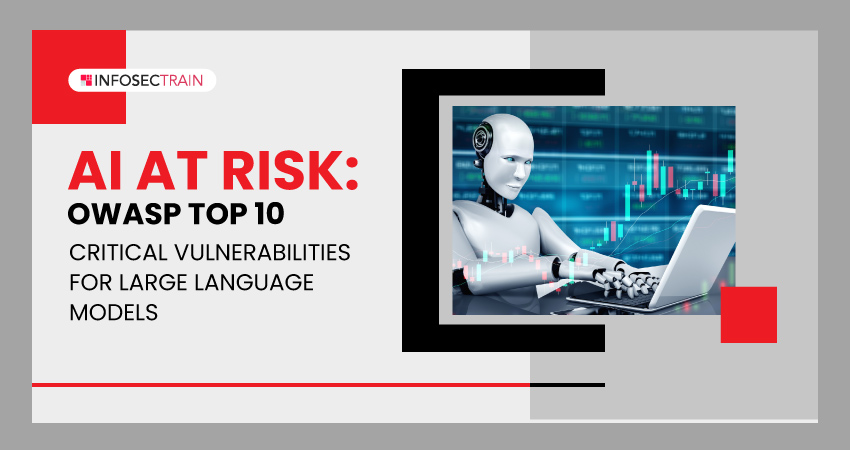AI at Risk: OWASP Top 10 Critical Vulnerabilities for Large Language Models (LLMs)
Artificial intelligence (AI) has transformed many industries by enabling extraordinary computation of natural languages, data analysis, and decision-making. The development of Large Language Models (LLMs) is one of the most significant developments in the field of AI. These algorithms, which were trained on massive amounts of data, demonstrate exceptional performance in various tasks, including language translation, text production, and sentiment analysis.

While Large Language Models (LLMs) have opened up new possibilities, they also pose substantial security risks. The potential impact of vulnerabilities in LLMs cannot be underestimated as AI applications become more integrated into critical infrastructure. To address these concerns, the Open Web Application Security Project (OWASP) has curated the “Top 10 Critical Vulnerabilities for Large Language Models.”
What is Large Language Models (LLMs)?
A large language model (LLM) is an artificial intelligence (AI) program that understands, summarizes, generates, and predicts new material leveraging deep learning techniques and extremely big databases. The phrase generative AI is also strongly associated with LLMs, a sort of generative AI specifically designed to assist in generating text-based material. Some of the most common applications of LLMs include:
- Chatbots and Virtual Assistants: LLMs can be utilized to develop chatbots capable of holding natural conversations with humans. In addition, they can be used to construct virtual assistants that assist users with tasks such as arranging appointments, booking flights, and making purchases.
- Content Generation: LLMs can generate different kinds of creative content, including articles, blog posts, and social media posts. They can also be utilized to translate text between languages.
- Question Answering: LLMs can be used to answer questions comprehensively and informally. They can access and process information from various sources, including the real world, the internet, and other databases.
- Sentiment Analysis: LLMs are used to determine whether a text’s sentiment is positive, negative, or neutral. This data can be utilized to enhance the performance of other AI systems, including chatbots and marketing campaigns.
What is OWASP and the Top 10 List?
OWASP stands for the “Open Web Application Security Project,” a non-profit organization dedicated to enhancing the security of software and web applications. The OWASP Top 10 List is a widely recognized document published by OWASP, outlining the ten most critical security risks commonly found in web applications. The list is updated to adapt to emerging threats and evolving security concerns. It guides developers, security professionals, and organizations to prioritize their efforts in securing web applications and mitigating common vulnerabilities that attackers often exploit.
OWASP Top 10 Critical Vulnerabilities for LLMs
OWASP has published a list of the top ten significant vulnerabilities that are frequently found in Large Language Model (LLM) applications. This list highlights the vulnerabilities’ potential impact, ease of exploitation, and prevalence.
OWASP aims to educate developers, designers, architects, managers, and organizations about potential security risks related to Large Language Models (LLMs). The list raises awareness of vulnerabilities, provides remediation strategies, and enhances the security posture of LLM applications. Here are the top 10 most critical vulnerabilities affecting LLM applications, according to OWASP.
1. Prompt Injections
Prompt injections occur when filters are bypassed or the LLM is manipulated with crafted prompts, causing it to ignore instructions or execute unintended actions. These vulnerabilities may lead to data leakage, unauthorized access, or security breaches. Common examples include bypassing filters, exploiting tokenization/encoding weaknesses, and providing misleading context to the LLM. Two types of prompt injections:
- Direct Prompt Injection/Jailbreaking: The attacker overwrites/reveals the system prompt, gaining access to insecure functions and data accessible by LLM.
- Indirect Prompt Injection: LLM accepts external source inputs controlled by the attacker, allowing conversation hijacking. Enables attackers to request sensitive information and manipulate decision-making.
2. Data Leakage
LLM accidentally reveals sensitive data through responses, leading to unauthorized access and privacy violations. Vulnerabilities: Incomplete filtering, memorization of data, and unintentional disclosures.
3. Inadequate Sandboxing
LLM lacks proper isolation from external resources, risking exploitation and unauthorized access. Vulnerabilities: Insufficient separation, excessive access to sensitive resources, and unrestricted interactions.
4. Unauthorized Code Execution
Malicious commands in natural language prompts target the underlying system. Vulnerabilities: Failure to restrict user input, insufficient restrictions, and exposing underlying systems.
5. SSRF Vulnerabilities
LLM is exploited for unintended tasks, accessing restricted resources like APIs. Vulnerabilities: Insufficient input validation, inadequate resource restrictions, and network misconfigurations.
6. Over-Reliance on LLM Content
Over-dependence on LLM-generated content without human insight leads to misinformation propagation. Vulnerabilities: Trusting LLM output without verification, accepting content as factful without human insight.
7. Inadequate AI Alignment
LLM objectives and behavior are misaligned with the intended use, causing harmful behavior. Vulnerabilities: Poorly defined objectives, improper training data alignment, and lack of testing.
8. Insufficient Access Controls
Improper implementation of access controls allows unauthorized users to exploit LLM. Vulnerabilities: Lack of strict authentication, inadequate role-based access control, and improper access controls.
9. Improper Error Handling
Error messages expose sensitive data, application details, and potential attack vectors. Vulnerabilities: Exposing sensitive information, leaking debugging details, and failure to handle errors gracefully.
10. Data Poisoning
Maliciously manipulated data introduces vulnerabilities or backdoors into LLM during the learning stage. Vulnerabilities: Backdoors in training data, biases injection, and exploitation during fine-tuning.
About InfosecTrain
The OWASP Top 10 LLM provides individuals and organizations dealing with large language models a guide to identify, assess, and address vulnerabilities and security issues. Detecting and mitigating these risks is crucial to preserving the LLM’s integrity. While the rapidly evolving AI landscape may lead to updates in the future, the current version aids developers and organizations in raising awareness and ensuring better security practices.
If you want to learn more about cybersecurity, InfosecTrain provides comprehensive training and certification courses. Our expert instructors, hands-on labs, and real-world case studies offer a valuable learning experience. Whether you are a beginner or an experienced professional, InfosecTrain has courses to enhance your cybersecurity knowledge and skills. Explore our offerings and take a step towards building a successful career in the cybersecurity domain.







 1800-843-7890 (India)
1800-843-7890 (India)